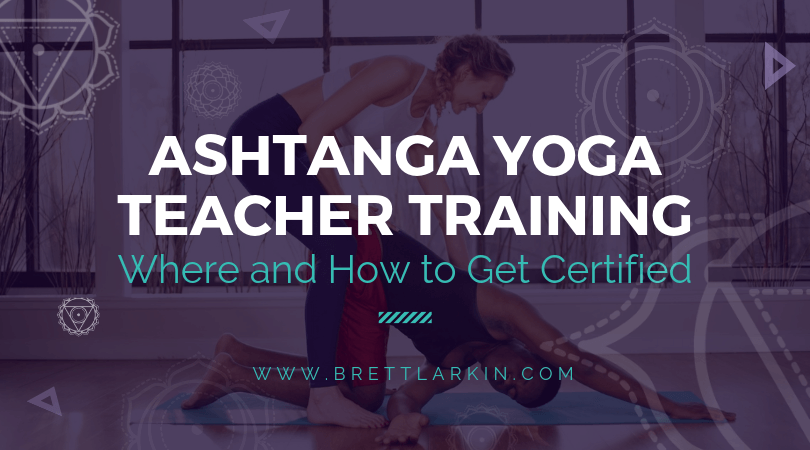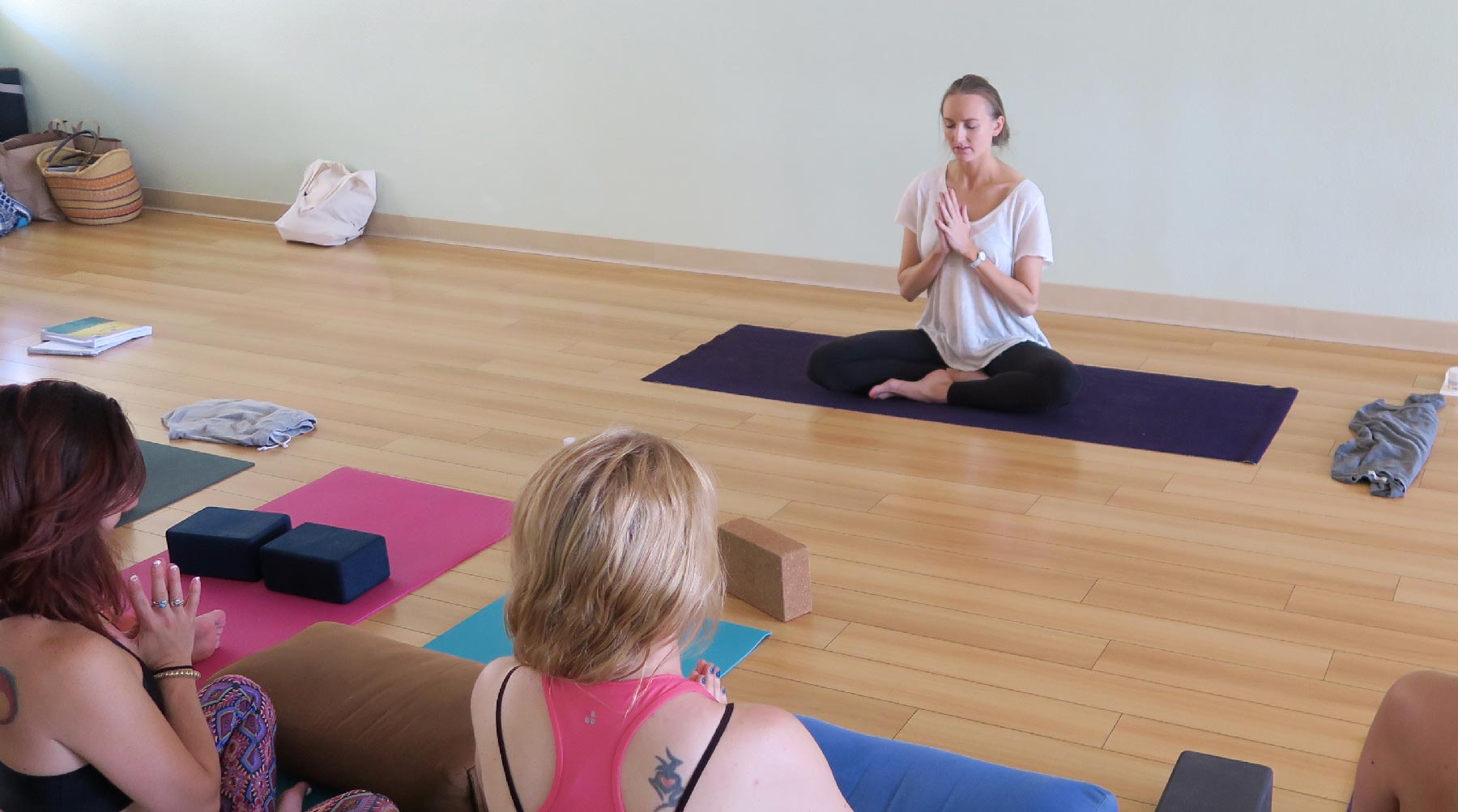
Listen, as much as I recognize that an authentic yoga practice has very little to do with the actual postures, sometimes I really just need a good workout.
And that’s exactly what Ashtanga yoga does for me. (If you haven’t tried it before, it’s a majorly blood-pumping set of yoga postures)
Even so, Ashtanga yoga is indeed a major part of traditional practice, according to Patanjali’s Yoga Sutras.
After all, the practice of yoga is all about balancing the mind and body through a meditation practice, pranayama breathing, and, of course, the yoga postures, as intense as they may be.
And if you absolutely love all that heat that the Ashtanga Vinyasa Primary Series builds, then maybe you wanna become an Ashtanga Vinyasa Yoga Teacher.
The problem?
Not all yoga teacher training courses go into Ashtanga yoga.
So if you want to get an in-depth understanding of this style of yoga, then you might want to look for a yoga school or instructor that focuses on Ashtanga exclusively.
Here’s a little bit more information to get you started.
Where does Ashtanga come from?

Ashtanga, the original power yoga, is no joke friends.
Founded in Mysore, India by Sri K. Pattabhi Jois in 1948. It was brought to the U.S. as a modern form of classical yoga. We have this motivated man to thank for bringing yoga to the western world!
Born from Patanjali’s Yoga Sutras, dating back to 350 B.C., two systems of yoga emerged. Kriya yoga (in relation to God) and Ashtanga referring to the 8 limbs of yoga. Beyond just the asana, Patanjali wove in these 8 limbs as a way to reach a higher consciousness or samadhi. These 8 limbs guide practitioners on their best path in life.
Like all forms of yoga having been birthed from Hatha yoga, ashtanga yoga falls under the umbrella of uniting opposites by creating balance in the body and linking breath with movement. Vinyasa yoga was adapted from Ashtanga and they are very closely connected as each relies heavily on pranayama and the ujjayi breathing technique as a focus.
The ashtanga vinyasa primary series forms the basis for all subsequent series. Each student must master every pose of the first series before moving on to the next, and this is all based on the teacher’s recommendations on how far you should be proceeding.
This is not a beginners class!
The ultimate goal of ashtanga is to purify the body and mind by creating heat leading to detoxification. There is also an incredible level of dedication and self-practice involved.
If you are a yoga teacher or practitioner who loves to push themselves and wants a more in-depth understanding of yourself and your limits, a teacher training program focusing on ashtanga could be just what you’re looking for.
You might also like: How to Be a Yoga Instructor: 6 Things You MUST Know Before You Begin
Where To Get Your Ashtanga Certification

If you’re a current yoga instructor or seeking to become one, there are many different options out there for additional certifications or 200-,300-, or 500- hour training programs. Many will teach a variety of yoga styles often coupling Hatha and ashtanga vinyasa together.
If you want to become officially certified as an ashtanga teacher you must study under Sharath Jois in Mysore, India at the KPJAYI aka the “main shala”. Only there can you be “authorized” to teach the practice to others.
(UPDATE: Sharath Jois passed away in November of 2024. You can still work with his family at the KPJAYI. Contact them for details on authorization.)
Because ashtanga is more foundational and deeply involves the yoga sutras, a 200-Hour teacher training course at a yoga school in Rishikesh, India, the yoga capital of the world, would provide a very authentic experience.
Don’t worry, though.
There are other options for TTCs (teacher training courses), if traveling abroad is not your first choice. They can be found around the corner at your local yoga studio or even online depending on your budget and what you are seeking to get out of a program.
These are some of the most popular yoga TTC options for the budding yoga instructor.
You might also like: Want to Become a Certified Vinyasa Yoga Teacher? Read This.
Take my quiz to find out which YTT is best for you:
Ashtanga Yoga Certification Immersion
Immersion yoga teacher training courses are short, intensive programs with a specific focus in mind. Each immersion typically consists of 45-60 contact hours with an additional 5 + hours of home study, depending on the program.
Immersions are not for substituting the 200-hour teacher training certification, though.
They are great for a beginners introduction to yoga or if you’re a yoga instructor looking for a deeper understanding of this style of yoga. Doing an immersion program could be added if you’d like to specialize in a form of yoga after you’ve already received your 200-HR certification.
Ashtanga Yoga Teacher Training Online
Another option for obtaining your YTTC is by doing your training online. Online training is great for current teachers with a busy schedule or for people with limited access to yoga where they live.
An online program is more flexible allowing you to decide when and how long the training will take place.
You will be presented with instructional videos, modules, assignments, and reading materials during the course of your training.
Currently, online programs focusing on ashtanga specifically are reserved for those who already have their 200-hour certification.
If you are looking to get certified as a yoga teacher, learning online is an option for you as most programs will provide all of the major aspects of training. This will include, the history of yoga, yoga asana, yogic philosophy, anatomy and physiology, meditation practice, and pranayama.
If it’s important for you to be RYT certified, Yoga Alliance does require some in-person elements in order to be certified.
Whether you are looking to supplement your current yoga practice or be certified, online is a great opportunity to expand your practice and further your education.
200-Hour Ashtanga Teacher Training
A 200-hour training is great for those who are really serious about deepening their knowledge and going beyond just the physical practice of yoga.
In addition to the ashtanga vinyasa primary series, you will learn the history, philosophy, pranayama, anatomy, meditation, alignment and teaching techniques. Many 200-hr ashtanga trainings also teach you about a yogic or ayurvedic diet as well.
Yoga Alliance USA requires that students have a minimum of 200 hours of study to begin teaching as a registered yoga teacher (RYT). If your goal is to become registered, you will want to make sure you do your training at a registered yoga school.
Before you sign up for a training program, it would be smart to do some of your own research into your potential yoga school.
Even if you never decide to teach, trainings can be life-changing! You will gain so much knowledge about yoga and yourself.
The bottom line with all YTTC is that you find a teacher or style that resonates with you.
If you love ashtanga and want that to be your focus, go to India and relish in all the ancient wisdom there, if you’re all about vinyasa or hatha, consider a quality online YTT or one at your local studio.
It is great to be well rounded as a teacher. Your students and your body will thank you!
Next Steps
- Check out my YouTube channel and find some yoga classes that you can try out for yourself!
- Explore my knowledge hub for How to Become a Yoga Teacher
- Attend a 200 YTT info session to see what else you’ll learn in my online teacher training.
Experience 3 Training Videos from Inside My 200-Hour Online YTT

YOU MIGHT ALSO LIKE
- What is Yoga Alliance and Do I Need an RYT Certificate to Teach Yoga?
- 200 Hour Yoga Teacher Training: What To Expect, How To Prepare, Where To Do It
- Is An Online Yoga Teacher Training Worth The Investment?
- Levels of Yoga Certification: What’s The Difference Between 200-, 300-, and 500-Hour YTT Courses?yoga certification
- What Does A 500 HR Yoga Teacher Training Course Cover? Standards and Benefits
- A Guide to The Best Yin Yoga Teacher Training Programs
- Hatha Yoga Teacher Training Certification: Immersion, Online, or in Studio?
- Wanna Teach Kids Yoga? Find A Fun Childrens Yoga Teacher Training!
- Ashtanga Yoga Teacher Certification: Where And How To Get It
- How To Know If An Online YTT Is Legit: 8 Things To Look For
- Want to Become a Certified Vinyasa Yoga Teacher? Read This.
- How to Choose a Yoga Teacher Training (That Won’t Rip You Off)










